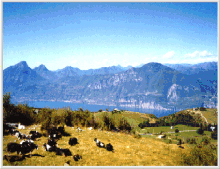

 |

|
|
Wave of bad weather in Puglia and Basilicata in Italy Large areas of Puglia and Basilicata regions have been hit by heavy rain and gusts of wind, with reports of one victim in Puglia along with uprooted trees and flooded crops (after a period of prolonged drought); meanwhile, in Basilicata many greenhouses for strawberry cultivation near Metaponto have been damaged or even destroyed and often the roads have cracked, causing interruptions in the road surface. To report turning the attention to other scenarios the repeated calls to stop deforestation due to uncontrolled development that has been ongoing for decades without any criteria in Southeast Asia following devastating floods that have scarred the land, with a death toll exceeding fifteen hundred persons and hundreds missing, causing great suffering for the population with impassable roads, collapsed bridges, and disrupted communications. e-mail: info@salutary.eu Tel: +39 338 1809310 Date: Dec 05, 2025  n: 6123
n: 6123
Deforestation in Indonesia linked to floods The loss of forests to make way for mining, cultivation and other human activities has, according to environmentalists contributed to floods and landslides, worsening damage in northern Sumatra due to tropical cyclone "Senyar", meanwhile the death toll in Indonesia has risen to over seven hundred people; then over one hundred seventy deaths in Thailand, and due to Cyclone "Ditwah" over four hundred deaths and three hundred missing in Sri Lanka. There is sometimes talk of deep grooves carved by the force of intense rainfall in elevated areas which have carried large masses of mud and debris funneling them into streets turned into muddy rivers that have flooded homes and businesses, making it difficult for people to even obtain food, and movements are almost always severely hindered in the affected areas. e-mail: info@salutary.eu Tel: +39 338 1809310 Date: Dec 04, 2025  n: 6122
n: 6122
Obstacles to sky observation in Atacama A project for a large renewable energy field with wind turbines, photovoltaic panels, a desalination plant and a port risks hindering sky observation in Atacama in Chile on the Pacific coast; at least according to astronomers who argue that one of the darkest spots on Earth, located in a desert and inhospitable area, making it suitable for studying the origins of the universe and planet formation, could be affected by light pollution, dust, vibrations, and even atmospheric turbulence. Regarding renewable energy it has long been requested that it be more ecological, with every component produced coming from a controlled supply chain that does not impact the environment during production, including the extraction of materials necessary for assembly or other production aspects. e-mail: info@salutary.eu Tel: +39 338 1809310 Date: Dec 03, 2025  n: 6121
n: 6121
Role of climate change in Asian floods With the death toll exceeding eleven hundred people across Thailand, Indonesia, and Sri Lanka, some have once again pointed out how climate change is causing extreme rainfall and significantly intensifying storms in the region. Meanwhile the situation in western Sumatra is particularly difficult for the population, often hungry and in need of everything while there is controversy over the slow arrival of aid and relief efforts, the floods have carried large amounts of mud and debris that hinder rescue operations to find the hundreds of people still missing, then digging is also needed beneath the numerous landslides. In Sri Lanka according to authorities international assistance is required in addition to the use of helicopters, then it is being described as one of the worst disasters in the country's history. e-mail: info@salutary.eu Tel: +39 338 1809310 Date: Dec 02, 2025  n: 6120
n: 6120
Devastation in Indonesia after a strong cyclone The death toll in western Sumatra is reported to have risen to over four hundred forty due to the tropical cyclone "Senyar," which three provinces devastated by landslides and floods after heavy rainfall, many areas are inaccessible due to impassable roads and communications are also difficult due to damage to telecommunications infrastructure. Some have requested a national state of emergency, there are numerous cases of submerged homes and people in severe distress needing aid, food and basic necessities. To report shifting focus to Sri Lanka across the Bay of Bengal more than one hundred fifty deaths and more than one hundred ninety missing due to cyclone "Ditwah" which recently caused floods and landslides on the island, affecting five hundred thousand people with severe weather. e-mail: info@salutary.eu Tel: +39 338 1809310 Date: Dec 01, 2025  n: 6119
n: 6119
Severe weather in Indonesia and Sri Lanka At least one hundred and eleven people are reported dead and over a hundred missing in North Sumatra due to the tropical cyclone called "Senyar", the local capital Medan has been flooded with muddy water causing inevitable serious disruptions for the population; in general landslides are reported after the heavy monsoon rains, often communications are cut off, there are power outages and some areas are covered with debris and therefore difficult to reach. Lhockseumawe the second city of Aceh is also flooded and the regional highway is unusable, resulting in paralysis throughout the region. As for Sri Lanka there are reports of sixty-nine deaths and thirty-four missing due to floods and landslides following torrential rains and strong wind gusts caused by cyclone "Ditwah", with road and rail traffic problems. e-mail: info@salutary.eu Tel: +39 338 1809310 Date: Nov 29, 2025  n: 6118
n: 6118
Potentially pandemic avian influenza Due to outbreaks of H5N1 avian influenza hundreds of millions of birds have been culled in recent years causing disruptions in food supply chains and rising prices, then the risk of a pandemic worse than that caused by the SARS-CoV-2 virus for Covid-19 is increasing, although for the moment human infections remain quite rare. According to experts the problem is that the virus could adapt to infect mammals and then humans potentially leading to human-to-human transmission, but unlike SARS-CoV-2 which was mainly lethal for vulnerable individuals avian influenza could be deadly for healthy individuals, including children; however several antiviral medicines are available that should be effective against the avian influenza virus allowing for vaccine preparation. e-mail: info@salutary.eu Tel: +39 338 1809310 Date: Nov 28, 2025  n: 6117
n: 6117
Flooding difficulties in southern Thailand The death toll in southern Thailand would have risen to thirty-three due to flooding after days of heavy rainfall in seven provinces, which authorities have described as the worst in three centuries. A state of emergency has been declared for Songkhla Province, with over twelve hundred residents forced to leave their flooded homes, the tourist destination of Hat Yai has also been affected. There are reports of people being electrocuted as well as drowned due to the torrents of overflowing water that have turned streets into rivers, with people trying to save themselves by swimming among cars and debris carried away by the force of the water. To report on a different note but still regarding environmental issues that the controversy over the limited results achieved by the COP30 climate conference in Brazil has not yet subsided, with the exit from fossil fuel use still seeming far off. e-mail: info@salutary.eu Tel: +39 338 1809310 Date: Nov 27, 2025  n: 6116
n: 6116
Bad weather in some regions of Italy Storms have caused the Sarno River in Campania region to overflow (also known for being one of the most polluted rivers in Europe), and several roads have been flooded, there are also reports of fallen trees and gusts of wind in this area due to the wave of bad weather, which has partially affected Tuscany region as well; then in the North there are sometimes reports of intense cold peaks as happened for example in the city of Bolzano. To report changing the topic but remaining within natural themes the disastrous situation in the Gaza Strip where heavy rainfall has caused the formation of muddy puddles in the large tent camps built with worn-out and inadequate materials, it is reported that eighty percent of the buildings have been destroyed due to the long-standing conflict in the area, the sewage systems do not work and all primary resources are scarce. e-mail: info@salutary.eu Tel: +39 338 1809310 Date: Nov 26, 2025  n: 6115
n: 6115
Floods in Thailand and damage assessment in Vietnam Days of heavy rainfall have caused widespread flooding in southern Thailand due to the collapse of sections of river embankments, at least one death has been reported in Songkhla province with thousands of people evacuated and entire districts flooded, and many flights canceled; affected residents are often forced to move through water and rescuers use boats to help people in distress. In Vietnam the death toll from recent floods in central areas of the country has reportedly risen to ninety-one with eleven people missing, authorities are assessing the extensive damage for recovery efforts: two hundred thirty-five thousand homes were flooded and eighty thousand hectares of crops were damaged, making this a climate event described as one of the worst in decades in terms of its impact on the territory. e-mail: info@salutary.eu Tel: +39 338 1809310 Date: Nov 25, 2025  n: 6114
n: 6114
First Page * The author doesn't assume some kind of responsibility for the bad use of the articles councils (all rights are reserved) |